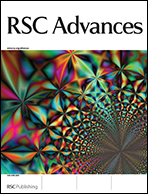A new insight into the electrochemical growth of Ag nanodendrites without a strong electrolyte
Abstract
We have developed a simple and green electrochemistry technique to synthesize Ag nanostructures with a highly pure, crystalline and smooth surface, which takes place in a clean and slow reaction environment (just highly pure de-ionized water) without any chemical additives. Here, we report a new insight into the Ag nanodendrite (ND) synthesis via the developed electrochemistry without a strong electrolyte. It is found that Ag2CO3 nanospindles and AgNDs form in water and on a graphite negative electrode, respectively, when an Ag target is immersed in the highly pure de-ionized water under an external voltage, which is totally different from conventional electrochemistry. The reaction processes are investigated in detail both theoretically and experimentally. The results show that CO2 from air plays a crucial role in the formation of AgNDs. CO2 is dissolved into the de-ionized water to form HCO3−, weak acid anions, which results in the formation of Ag2CO3. Then, Ag+ is reduced to metallic AgNDs on the negative graphite electrode. The AgND modified graphite electrode (AgND/GE) shows a significant improvement in the electroreduction of H2O2 compared to the bare graphite electrode. These investigations suggest that introducing a weak electrolyte in the electrochemical cell offers an alternative route to design and fabricate novel nanostructures for practical applications.


 Please wait while we load your content...
Please wait while we load your content...